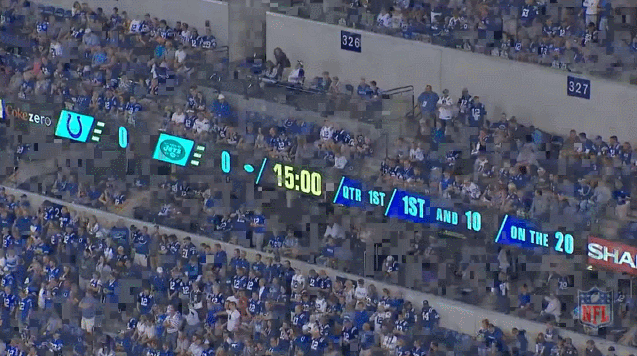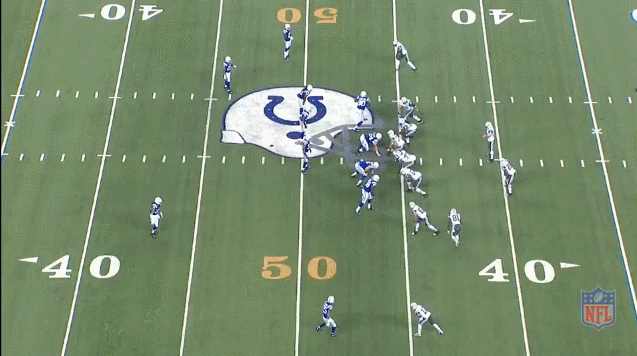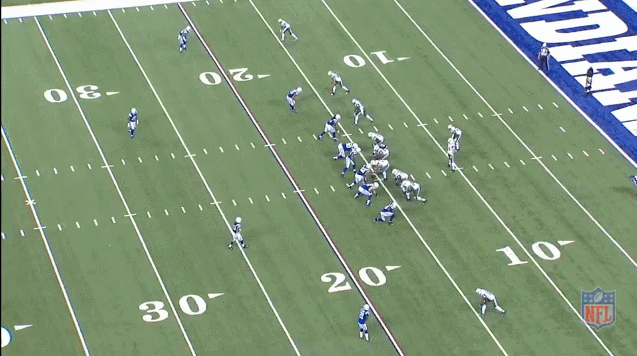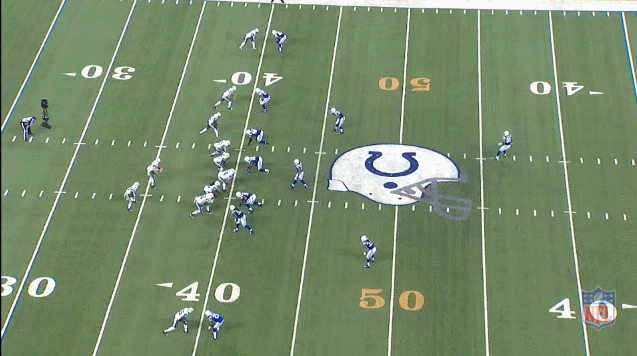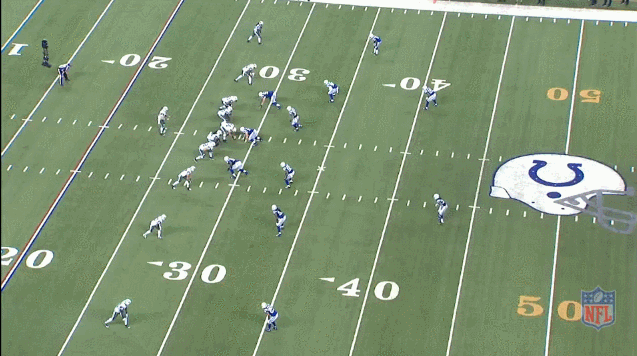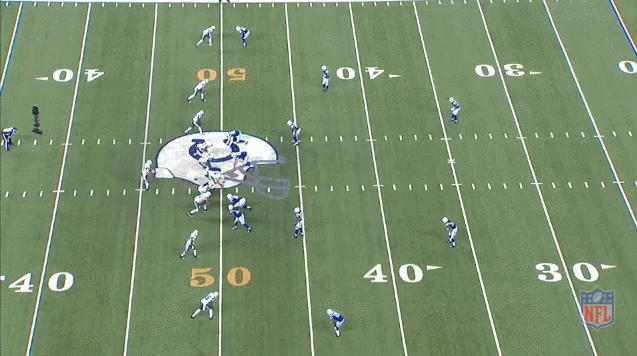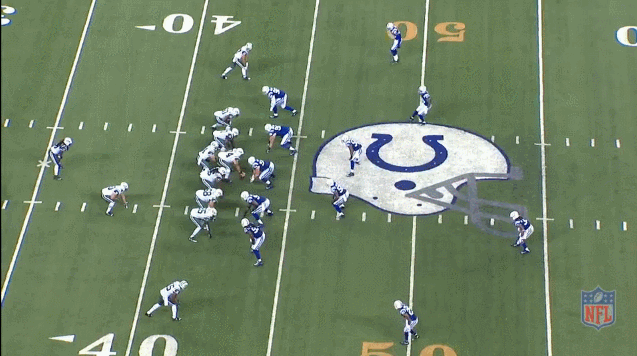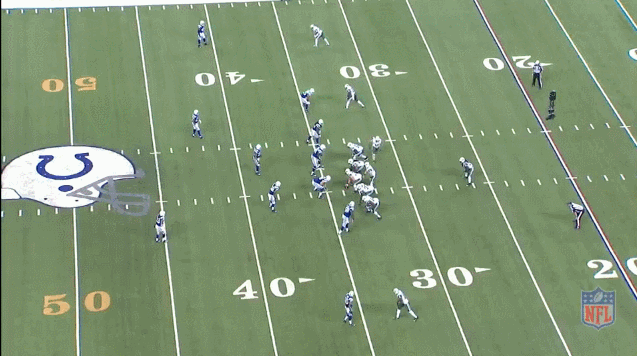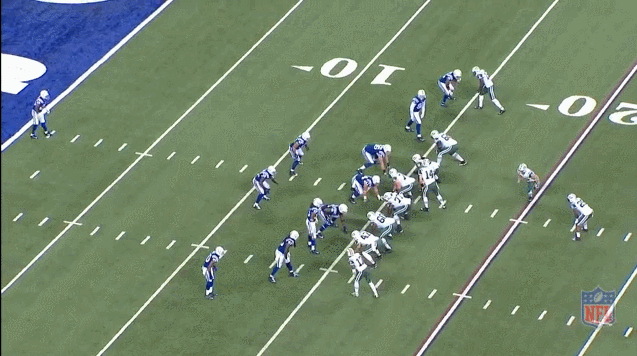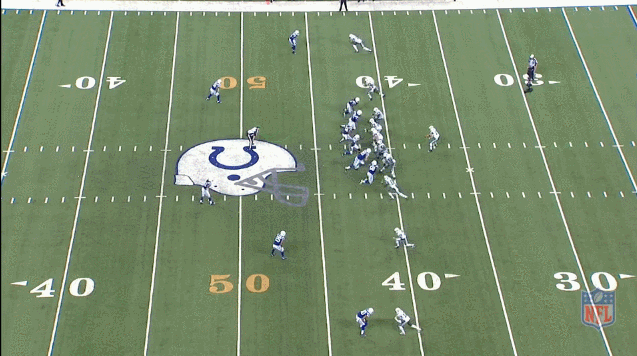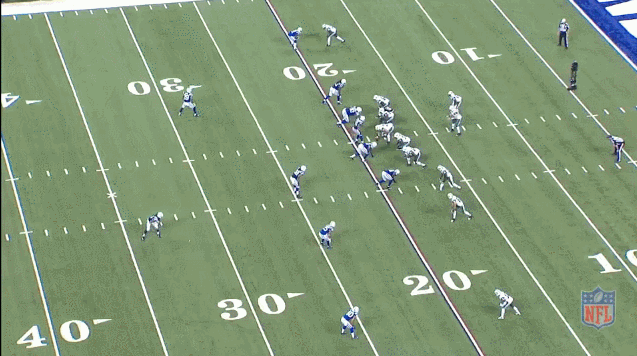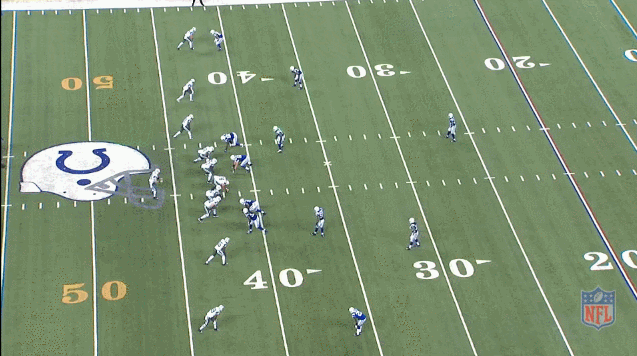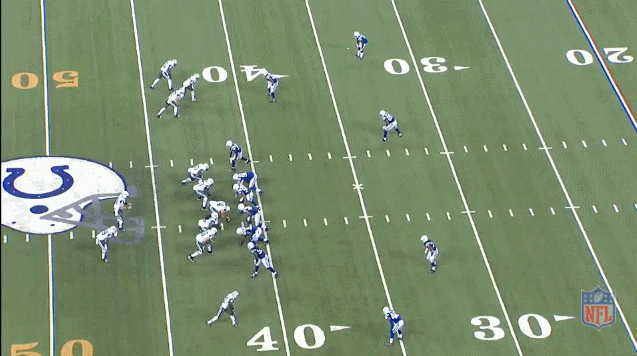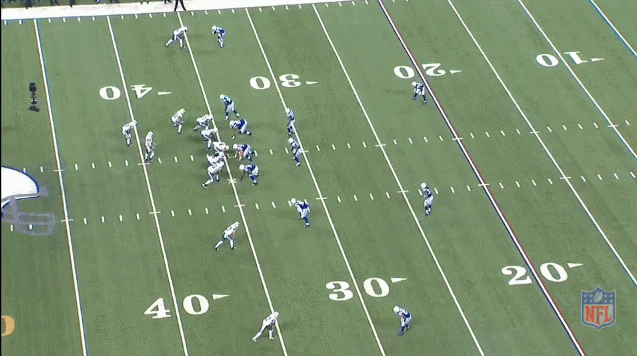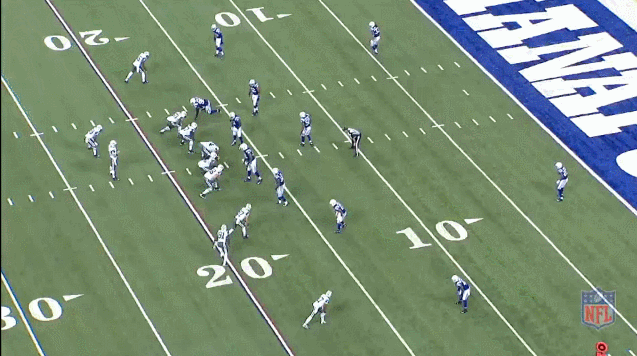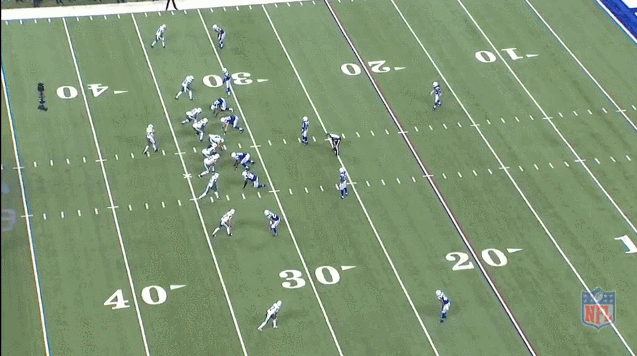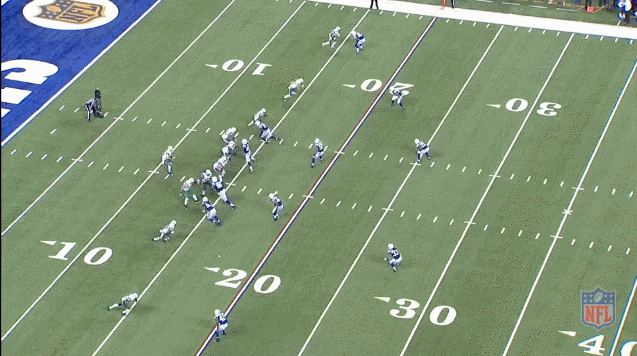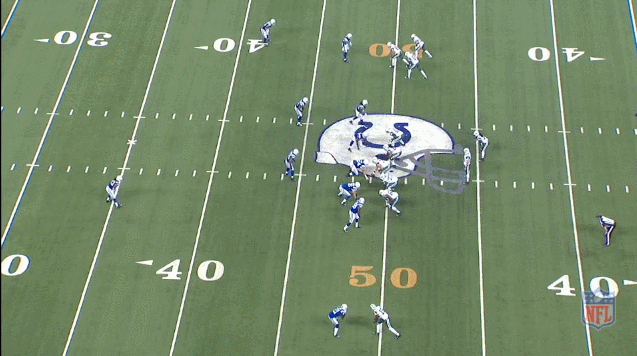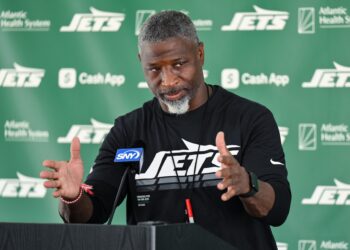Breaking News Featured Editorials Home Slider QB Film Review
Jets Passing Offense Film Review- Week 2
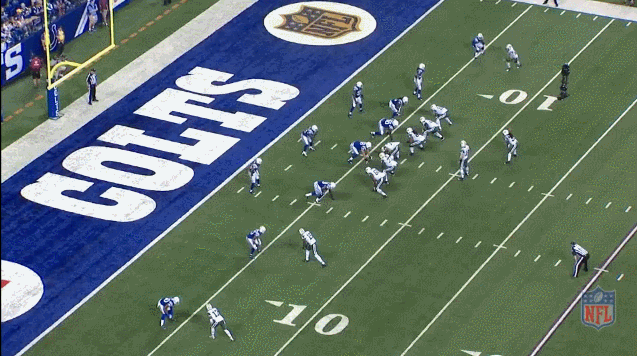
The Jets had another good, albeit not spectacular day in the passing department against the Colts on Monday night. For most of the night, the team seemed to go very conservative with a small lead, especially when they reached mid-field. Fitzpatrick made some good plays in the passing game, and some horrible decisions, while some of the WRs also made bad plays to worsen the situation including a couple of key drops from Enunwa. Let’s examine how things went down:
Good Magic:
The first pass of the game is a clinic of how the spread system has helped us open up the passing game and create passing lanes. On the outset, this is a simple out route to Decker from the slot. However, the most important aspect of this play is Ivory going in motion. As soon as Ivory goes in motion, all linebackers take one extra step towards the side that Ivory is running to (Jets’ left, Colts’ right side) including the LB that is covering Decker. This allows extra space for Decker to operate in when making the out route, creating an even better passing lane for Fitzpatrick. Another thing to notice, this is a symmetrical play on both sides, so the same exact option exists on both sides of the ball. The outside WRs run the post to clear their defender from the area, and the inside WR makes an out route. This is built in security if the safety comes down into the box to take away one of the slot WRs. It’s a simple outcome in the play, but a very complex execution. Also, remember the idea of outside WR running off the defender, with slot WR going to the out route, the Jets use it a few times in this game.
There is the pre-snap movement, and there is the outside WRs clearing out again. This time Enunwa runs across the field and it causes some substantial changes in the defense. For one, the safety on Marshall’s side now comes down to defend Marshall because the CB covering Marshall is now occupied with Enunwa. This forces the other safety on Decker’s side to move deeper to function as the single high safety, thus it’s an easy mismatch with a LB that is basically standing at the line of scrimmage against Decker. This is another case of using the spread system and late movements to create mismatches that may not have existed otherwise. It’s an excellent play call, and a very good execution. Also note the symmetrical aspect of the options (albeit Marshall runs a quick comeback route instead of an out route) but Fitzpatrick has both options in the slot open. He chose the left side, because Decker vs. LB is a better matchup than Marshall vs. safety.
The first touchdown of the game comes from a play that is reminiscent of something that the Patriots and Broncos run. With 4 wide, the defense has to choose which WR to double and then face a single matchup on the other. The Colts make the logical choice here of putting their best CB (Davis) on Decker and then double teaming Marshall. However, the Jets steal a play from the Pats, and run a pick play (same thing the Seahawks failed at on that infamous last pass) where the inside WR (in this case, TE) and the outside WR criss cross. This forces the defense to have one defender run around his teammate, causing separation and an easy completion. In this case, when the TE crosses Decker, his defender is right next to him, causing Davis to run around and leaving an easy throw for Fitzpatrick to make to Decker. However, this play is extremely effective near the goal line, because the QB’s job is to really just read the inside defender and go to the other guy. If Vontae Davis cuts inside, then this is an easy pass to Cumberland on the outside because his defender has to run around Davis.
This is a huge play in the game, with Fitzpatrick and Marshall making a great read together on the play. The play is again 4 WRs spread out with one on one matchups and 2 safeties over the top. However, for a 3rd and 3, the two outside CBs are both playing off the ball. In this case, Davis is trying to make a play and for some reason jumps upfield to cover Powell. However, the DE comes off the line to cover him. This looks like defensive confusion resulting from moving Powell from the right side to the left side. Vontae Davis assumes that no one is there to cover Powell on the play, and jumps out to meet him on the short yardage play. He realizes it too late that the play isn’t for Powell, but by then Marshall makes a great read and essentially sits in the empty zone for the easy pass. Good job by Fitzpatrick to read the situation and make a good throw, and great job by Marshall making a play after the ball. However, I believe the main catalyst for this play is the movement of Powell creating confusion at the last minute. This is one of the aspects of the spread system that make it hard to defend because there are so many options that the defense has to contend with, along with extra spacing, that they are bound to make some mistakes every now and then just by subtle changes.
Remember the concept from earlier in the game, with the outside WR running a clear out, slot WR running the out route for easy completions? Well this one is a great lesson in counter adjustments by Chan Gailey. The same concept applies here, the outside WR runs a clear out (and gets mugged, should’ve been a holding penalty) and the first slot WR runs the out route. However, the Colts adjust by having the defender close to the out route ready to jump the passing lane. Not to be outdone, Gailey designs a second out route down the field with Decker against a LB as the safety valve. So the read on this play is simple, the first out route should be the first read, if that is covered, it means the LB on the slot WR has vacated the middle of the field, so as soon as Decker makes his move inside, Fitzpatrick can make the throw. This is a pretty simple read, easy throw, and a prime example of how Gailey has set up similar plays with safety valves that the Colts couldn’t adjust to with the players they had on the field.
Same play as before, just on the other side. It’s the same exact concept again, outside WR runs off his defender. The slot WR on the inside runs the out route, and again his defender plays close to him. Thus, the play is a one on one matchup with Decker in the open field, and that is basically just a pitch and catch. One of the things you hear about the spread systems in general and the system that Gailey runs is that, they aren’t extensive amount of plays involved. They mainly deal with a few concepts that the team perfects with various safety valves built in, so it doesn’t take a genius to figure it out. I believe it was Bryce Petty that said the playbook wasn’t that unfamiliar to the one he ran in Baylor. This is just another example of one type of play that the Jets kept returning to in this game.
In this article, you are going to read this play first, however in the game flow another play happened first in the game. Please scroll down to Magician’s Assistants Fail and watch the second play listed there. Go on, scroll down. Ok, now that you have seen that play, you’ll understand the adjustment made on this play by Fitzpatrick. It’s essentially the same exact play but this time Fitzpatrick makes the right throw. 5 WR wide, the bottom two run the now very familiar WR clear out and out route combo that has been seen so many times now. The 3 WRs on top run the shallow cross with Enunwa, and then the medium cross with Decker (that Owusu ran on the aforementioned drop play you scrolled down to). You have to give credit to either Fitzpatrick or Gailey, or both, for recognizing the error in their previous play and correcting it this time and gaining 19 yards out of it.
This is a great play call by Gailey, and it provides Fitz with two distinct and somewhat easy options to pass. The first option to pass is to the TE Cumberland, when the DE comes off of him for the pass rush. A pass to the TE in that play should result in about 5 yards of positive movement upfield. However, the second option is a pass to Marshall further down the field, and Marshall schools the DB and creates an easy throwing opportunity. The timing on this play is exquisite as well.
This is a huge play in the game, especially after the Colts scored a TD and the Jets needed to answer. The basics of the play is simple, Enunwa runs a deep post route, Fitzpatrick hits him in stride. However, the complexity of this play is fascinating. First of all, the motion to the left side pulls in the safety from a two safety look to a single high safety look. Notice with the motion, the safety moves up 5 yards, and when Enunwa catches the ball, there is a 5 yard separation between him and the now retreating safety. Without that motion, this most likely is not a completion. The second aspect of the play is something that has been seen many times by the Colts, and counter adjusting when needed by Gailey. As the player motions out, notice the lack of movement by the LB covering Enunwa. There is even a slight hint that the LB moves a bit to the outside of Enunwa. Why? Because the outside WR running a go route, with the slot WR running the out route has been repeated so many times. However, Gailey throws a wrench in their plans by having Enunwa run a post route instead. The LB allows Enunwa to get an easy release inside this time, allowing him to separate from the defender and create an opportunity. While this is a great throw and a nice catch, this play is almost entirely up to the genius of Gailey and how all the prior plays set this one up.
To cap off a very good drive, there is the final TD to Marshall. This is just a great throw and placement by Fitzpatrick, and an even better run after the catch by Marshall carrying two defenders into the end zone. The back shoulder pass is one of the hardest passes to defend for a CB and it’s pretty well executed here.
This play is here for a few reasons. One, it’s such a deviation from the regimes of years past that it needs to be highlighted. This play occurs with the Jets up 10 with a little over 4 minutes left in the game on 3rd and 5. The last few years, this is a guaranteed run up the middle for three yards, and punt. Instead, the Jets go 5 wide, and the same exact play that has been talked about ad nauseum occurs again. The outside WR runs a go route, the slot WR runs an out route. The Colts are even ready for this play, as the outside CB abandons Marshall (partially because it’s a blitz) and tries to make a play, but the Jets are so well versed in this play, that it’s executed anyway. This play also highlights one of the benefits of a spread formation. On a tighter formation, when the CB abandons his WR on a blitz as this one, he has less ground to cover and is much more likely to make a play on the ball. In the spread formation, there is more ground to cover so he wasn’t able to get there in time, even though his diagnosis of the play was correct.
Magician’s Assistants Fail:
Now remember the plays from before, where the outside WR is running a go route to clear out space. This happens again here, with one major problem: Colts get pressure on Fitzpatrick. From the design of the play, this is a two read play. The first read is Enunwa on the outside slant again from the slot (same idea as before) with the secondary play being a screen pass to Powell. However, the safety reads the play to Enunwa and is about the jump the route, and Fitzpatrick faces pressure. With Decker running right to the safety, Fitz assumes the over the top safety will go towards him, and is right when he takes a step towards Decker when the ball is thrown. However, the play is botched because Owusu did not understand that he was still part of the play. He clearly stops running because the main design of this play calls for him to just run a clear out and then look back to block if need be. If he keeps running, it’s a 50/50 ball at best, but it’s better than nothing. This one is on Owusu here as he needed to keep running on the play when it broke down, but his limited experience hurt him.
This play on 2nd and 9 had pretty much everyone signing their name on the release Enunwa letter. However, Fitz shares some blame on this as well, because he has a wide open Owusu running another slant behind Enunwa and decided not to throw to him. On another angle, it’s clear that Fitz is actually looking right at Owusu, and then at the last second decided to throw to Enunwa. However, he does make a good throw and it’s on Enunwa for dropping an easy pass. The easier throw is to Owusu, and it also presented more of an opportunity for a first down.
Bad Magic:
The play was clearly a blunder as soon as everyone saw the TV replay with Decker standing wide open right in Fitz’s sightline. Infact, the deep pass to Owusu is the worst choice he has on the board. Besides a wide open Decker waiting there for a big gain, there is Enunwa running a deep post route with one on one matchup as well. He also has a crossing route available for minimal gain. However, Fitzpatrick throws the ball into triple coverage for some reason. This is a disaster play that the Jets were lucky fell for an incompletion.
Another horrendous decision by Fitzpatrick on a deep pass. Marshall is clearly the worst option on the board again, and yet Fitzpatrick goes down the left sideline for a deep pass. There are three options on the field for Fitzpatrick to choose from, and he picked the worst one again. He has Decker open on an easy comeback route that is a surefire first down. He has Owusu on a one on one matchup with the safety and inside slant as well, yet Fitzpatrick goes to Marshall, and the safety makes a great play to get the interception. The play calling on this was excellent, because Gailey provides two good options for Fitzpatrick, yet he ignored it for some reason. Not only does he pick the wrong choice, he also makes the wrong throw for the situation. At the time of the throw, Davis has inside position on Marshall with his back turned to the QB. This is the ideal back shoulder throw area because the CB has to turn his body completely around in an almost 200 degree angle to make a play on the ball, or stop his momentum and reverse course faster than the WR (as discussed on the Marshall TD against Haden last week). This is still a 50/50 ball but the ball bounces in play and the safety makes a great play. However, it is still a horrible decision and throw by Fitzpatrick. Two of his worst throws were on the left side of the field deep in this game.
This is again, a similar play as to what was run in a lot of sets before. Enunwa goes in motion to the outside, and then runs a clearing route. However, Marshall seems to round off his route a bit too much, and essentially ends up out of the play. Nevertheless, Fitzpatrick has an easy throw to Powell running across the field and there is a good chance he runs to the 9 yard line on this play for the first round if he hits him in stride. However, Fitz throws behind, Powell tips the ball, and almost ends in disaster with a possible interception. This is a simple pass that has to be on point and misses like this were part of the reason the Jets only put up 20 points on the Colts.
This is the third baffling deep ball pass to Fitz’s left that makes no sense at all. On 2nd and 10 in Colts territory, Fitzpatrick has Owusu for an easy short completion, and a one on one matchup that should’ve been called for holding with Decker. Either of those plays are exponentially better bets than this deep pass to Marshall. Infact, in another angle, Fitzpatrick clearly looks at his right side, but turn to his left side with his mind made up to throw. The whole line of thinking seems to be that the high safety was going to be stuck in the middle of the field, but he wasn’t. There is no reason for this ball to be thrown to Marshall. It’s the second worst option on the field. There is an easy out route throw on Marshall’s side that should gain about 5 or 6 yards, but also be able to go out of bounds. For all the media that seem to love Fitzpatrick’s smarts, he’s made three terrible reads on deep passes when he had other options and other angles have shown him actually looking directly at those options and then flinging it deep to the left.
Another example of Fitzpatrick throwing a ball deep and missing in this game, thus making the wrong read. This play occurs on 3rd and 5 right after the Gore fumble at the goal line and a tired Jets defense. Gailey calls the exact same play that has been repeated over and over again in this game to Fitz’s right. Marshall runs the go route, Powell runs the out route in this case. The read on this is simple, if the CB goes with Marshall, take the easy first down to Powell. However, Fitzpatrick tries for an incredibly hard throw to reach Marshall over the CB (who has inside position) before the safety can come over the top. At a point where the defense needed some rest, this is a major missed opportunity to not only burn some clock but continue the drive so the defense can recover.
Chip Kelly Effect:
This is mostly interesting because of who the next opponent is and why they might be struggling. The play is a staple of the Chip Kelly offense and is widely used in spread systems across the board in college. It’s a spread bunch formation with three WRs, with two of them eventually functioning as blockers for the WR screen behind them. However, as mentioned on the broadcast, many teams complained to the NFL that the WRs were engaging in blocks before the pass was thrown, so the refs have been more vigilant about the timing of the blocks. In this case, Decker gets a penalty for blocking too early, and the gain is negated. If you watch game tape of Marcus Mariota from college, you’ll see Oregon run variations of this play at a high level. They will run the WR screen, but also fake the WR screen with the WRs that were pretending to be blocking run down the field past the defense for big gains. With the enforcement of the blocking rules being more stringent now, this hurts the offense that is being run by Chip Kelly because it takes away a major weapon they have used in the past, or atleast reduces the impact of it because now the block timing has to be synchronized better. Also making things harder now, blocking is heavily reliant on the position of DBs more than ever on this play, leading them having to audible out of the play at times.
Overall, this was a good showing by the Jets offense, but there were a bunch of missed opportunities that cost points. The design of these plays by Chan Gailey is very impressive, and the move to the spread system is a welcome change for the offense. The whole system is based on perfecting a limited number of plays, and that was exemplified in the Colts game on Monday. The Jets ran very similar plays on numerous occasions and were in position to score a lot more points than the scoreboard would have you believe. Fitzpatrick had his moments and also had some puzzling decisions, but overall the Jets avoided too many costly turnovers and ended up winning by a good margin.
Videos
Taking a Look at Jets Strengths and Weaknesses Ahead of Opener; John Simpson Update

